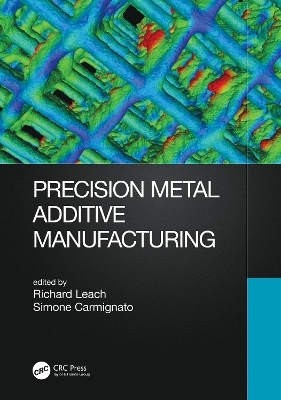
Precision Metal Additive Manufacturing
CRC Press (Verlag)
978-1-138-34771-7 (ISBN)
In recent years, there have been dramatic improvements in AM design methods, process control, post-processing, material properties and material range. However, if AM is going to gain a significant market share, it must be developed into a true precision manufacturing method. The production of precision parts relies on three principles:
Production is robust (i.e. all sensitive parameters can be controlled).
Production is predictable (for example, the shrinkage that occurs is acceptable because it can be predicted and compensated in the design).
Parts are measurable (as without metrology, accuracy, repeatability and quality assurance cannot be known).
AM of metals is inherently a high-energy process with many sensitive and inter-related process parameters, making it susceptible to thermal distortions, defects and process drift. The complete modelling of these processes is beyond current computational power, and novel methods are needed to practicably predict performance and inform design. In addition, metal AM produces highly textured surfaces and complex surface features that stretch the limits of contemporary metrology. With so many factors to consider, there is a significant shortage of background material on how to inject precision into AM processes. Shortage in such material is an important barrier for a wider uptake of advanced manufacturing technologies, and a comprehensive book is thus needed.
This book aims to inform the reader how to improve the precision of metal AM processes by tackling the three principles of robustness, predictability and metrology, and by developing computer-aided engineering methods that empower rather than limit AM design.
Richard Leach is a professor in metrology at the University of Nottingham and heads up the Manufacturing Metrology Team. Prior to this position, he was at the National Physical Laboratory from 1990 to 2014. His primary love is instrument building, from concept to final installation, and his current interests are the dimensional measurement of precision and additive manufactured structures. His research themes include the measurement of surface topography, the development of methods for measuring 3D structures, the development of methods for controlling large surfaces to high resolution in industrial applications and the traceability of X-ray computed tomography. He is a leader of several professional societies and a visiting professor at Loughborough University and the Harbin Institute of Technology.
Simone Carmignato is a professor in manufacturing engineering at the University of Padua. His main research activities are in the areas of precision manufacturing, dimensional metrology and industrial computed tomography. He is the author of books and hundreds of scientific papers, and he is an active member of leading technical and scientific societies. He has been chairman, organiser and keynote speaker for several international conferences, and received national and international awards, including the Taylor Medal from CIRP, the International Academy for Production Engineering.
Richard Leach is a professor in metrology at the University of Nottingham and heads up the Manufacturing Metrology Team. Prior to this position, he was at the National Physical Laboratory from 1990 to 2014. His primary love is instrument building, from concept to final installation, and his current interests are the dimensional measurement of precision and additive manufactured structures. His research themes include the measurement of surface topography, the development of methods for measuring 3D structures, the development of methods for controlling large surfaces to high resolution in industrial applications and the traceability of X-ray computed tomography. He is a leader of several professional societies and a visiting professor at Loughborough University and the Harbin Institute of Technology. Simone Carmignato is a professor in manufacturing engineering at the University of Padua. His main research activities are in the areas of precision manufacturing, dimensional metrology and industrial computed tomography. He is an active member of leading technical and scientific societies. He has been chairman, organiser and keynote speaker for several international conferences, and received national and international awards, including the Taylor Medal from CIRP, the International Academy for Production Engineering.
1 Introduction to Precision Metal Additive Manufacturing.............................................1
Martin Baumers, Simone Carmignato and Richard Leach
2 Topology Optimisation Techniques ................................................................................. 11
Rajit Ranjan, Can Ayas, Matthijs Langelaar and Fred van Keulen
3 Development of Precision Additive Manufacturing Processes...................................35
Ahmed Elkaseer, Amal Charles and Steffen G. Scholz
4 Modelling Techniques to Enhance Precision in Metal Additive Manufacturing........ 69
Sankhya Mohanty and Jesper H. Hattel
5 Secondary Finishing Operations.......................................................................................97
Bethan Smith, David Gilbert and Lewis Newton
6 Standards in Additive Manufacturing........................................................................... 133
David Butler and Peter Woolliams
7 Cost Implications of Precision Additive Manufacturing............................................ 157
Martin Baumers
8 Machine Performance Evaluation.................................................................................... 171
Shawn Moylan
9 Non-Destructive Evaluation for Additive Manufacturing......................................... 195
Ben Dutton and Wilson Vesga
10 Post-Process Coordinate Metrology................................................................................ 237
Richard Leach and Amrozia Shaheen
11 Post-Process Surface Metrology....................................................................................... 269
Nicola Senin and Francois Blateyron
12 X-Ray Computed Tomography.......................................................................................... 313
Simone Carmignato, Filippo Zanini, Markus Baier and Elia Sbettega
13 On-Machine Measurement, Monitoring and Control.................................................347
Bianca Maria Colosimo and Marco Grasso
| Erscheinungsdatum | 10.06.2019 |
|---|---|
| Zusatzinfo | 33 Tables, black and white; 47 Line drawings, black and white; 140 Halftones, black and white; 187 Illustrations, black and white |
| Verlagsort | London |
| Sprache | englisch |
| Maße | 178 x 254 mm |
| Gewicht | 453 g |
| Themenwelt | Technik ► Bauwesen |
| Technik ► Maschinenbau | |
| Technik ► Umwelttechnik / Biotechnologie | |
| ISBN-10 | 1-138-34771-X / 113834771X |
| ISBN-13 | 978-1-138-34771-7 / 9781138347717 |
| Zustand | Neuware |
| Informationen gemäß Produktsicherheitsverordnung (GPSR) | |
| Haben Sie eine Frage zum Produkt? |
aus dem Bereich


